the labour market chap 16-18
1/75
Earn XP
Description and Tags
demand for labour, supply of labour, interaction of labour markets
Name | Mastery | Learn | Test | Matching | Spaced |
|---|
No study sessions yet.
76 Terms
what type of demand is labour
derived demand
why is labour a form of derived demand
valued for the labour of output produced, many sub markets within labour so derived demand depends on a multitude of factors
what does the labour demand curve look like and why
downward sloping curve due to the law of diminishing returns especially in the short run
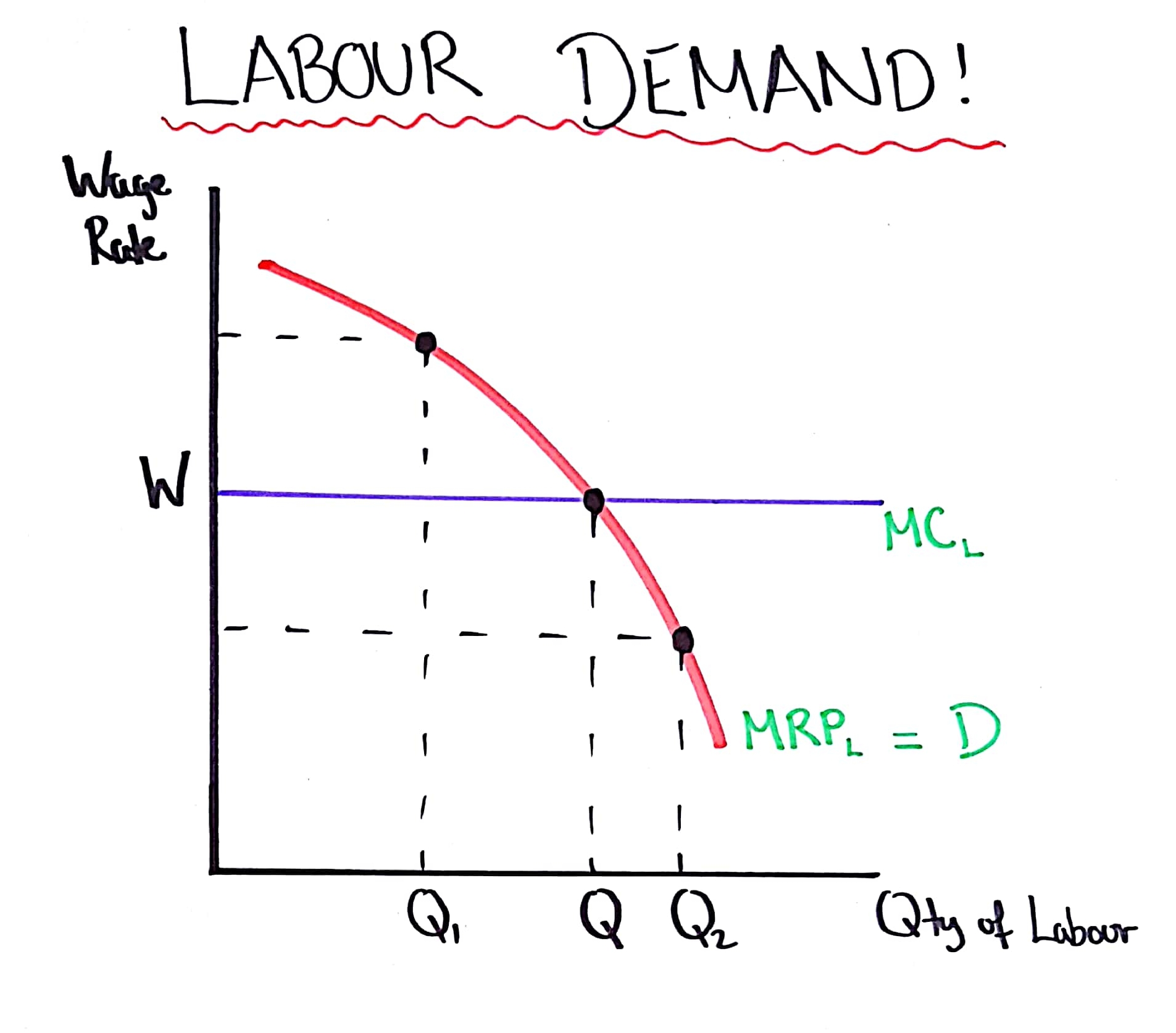
what is the marginal physical product of labour
the additional output per unit of labour (MPPL)
what form of marginal product does the labour demand curve usually use and why, draw this on a perfectly competitive market
the marginal revenue product of labour (MRPL) where marginal revenue is considered alongside marginal physical product of labour (MR x MPPL)
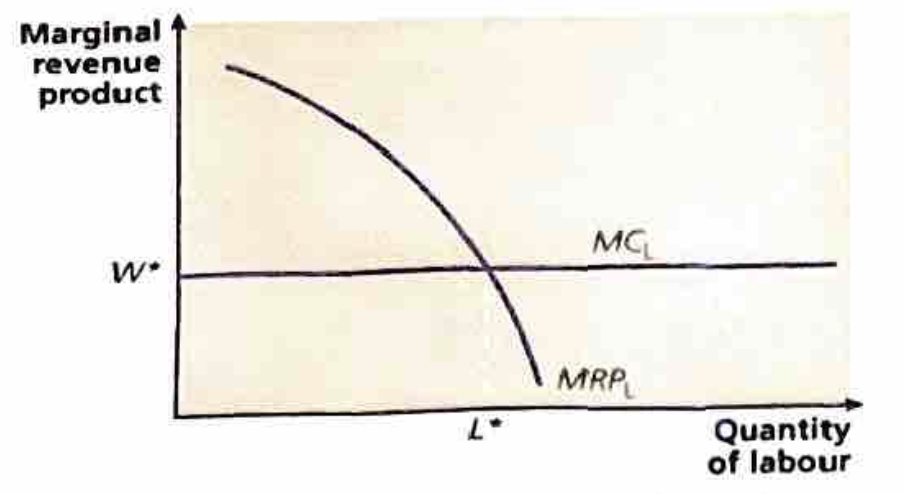
in perfect competition, what is constant within the labour market
the wage rate as everyone is following the same policies such as minimum wage and there is symmetric information
what is the marginal revenue product theory
the demand for labour depends on balancing firms revenue from more labour (MRPL) against the marginal cost of the unit of labour (MPPL)
where will a firm maximise profit on a labour demand curve
where MRPL = MCL (MR=MC) in labour terms
what are the two categories of factors that effect the position of the labour demand curve
anything that affects MPPL or MR
what factors affecting MPPL can effect the position of the labour demand curve
advancements in technology to improve productivity, incentivised productivity
what factors affecting MR can effect the position of the labour demand curve
changes in the price of a product such as a change in raw material from input, changes in price equilibrium from demand shifts changes the marginal revenue and therefore labour demand
link labour demand to the economic cycle
in a period of recession, the marginal revenue of a product is low due to low demand which means less demand for labour, opposite for a boom
what factor changes the shape of the labour demand curve
wage elasticity of demand
what are the three main factors that affect the wage elasticity of demand
ease of factor substitution, share of labour within a firms total costs, PED of the product
how does the ease of factor substitution affect the wage elasticity of demand
if other factor inputs such as technology are readily available and cheap to use then firms are likely to have a high sensitivity to wage fluctuations, varies between economic activities for a replacement by capital ie office workers vs factory workers
when is capital input flexible
more flexible in the long run than the short run as firms have more money and availability to balance the different factors of production within their business
how does the share of labour within total costs affect the wage elasticity of demand
if a firm has a high wage cost (tertiary) then they are likely to be more sensitive to wage changes, lower wage costs within total costs mean less sensitive to wage price changes
how does the PED of the product affect the wage elasticity of demand
if a product has a high PED ie the product is elastic and demand is sensitive to a price change therefore firms will be more sensitive to wage rate changes as demand for the product is already volatile, a low PED and inelastic demand means that a firm will be less sensitive to wage changes as their revenue is more constant
labour productivity
measure for the output per hours worked
what are the three main influences on labour productivity
skills and training of the workforce, availability of complementary factor inputs such as capital and technology, organisation of the production process
what are some examples of influences on labour productivity
workers with a higher level of education, efficient division of labour by skillset, technology that enhances workflow
unit labour costs
average cost of labour per unit of output, depends on wage rate and productivity
when thinking of labour supply, what is helpful to picture it from
an individual job perspective rather than an industry such as accountants rather than the financial sector as they have different types of supply associated for different roles
what does the industry labour supply diagram look like and why
upwards sloping as a higher wage rate mens that there are more hours of labour available as more people are likely to apply for the job
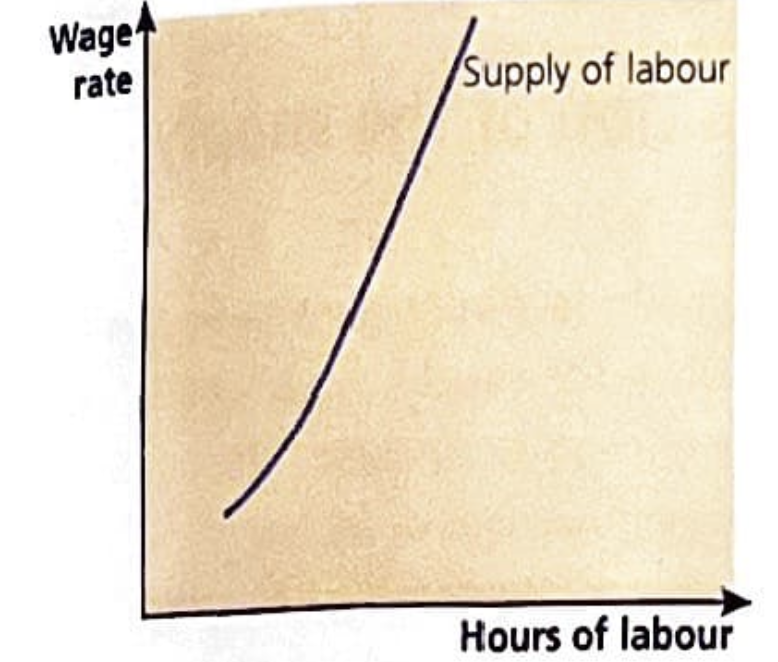
what is the wage rate in labour supply also seen as
the opportunity cost of leisure time, people give up their time to work
when people give up their leisure time to work, what is this called
the substitution effect as the opportunity cost of not applying for labour is so high that they substitute their time for wages (price of leisure is therefore higher)
how does the wealth/ income effect link to labour supply and wage rate
when rage rate is high and supply of labour is high, more people will have more disposable income which leads to the income effect as they are able to afford more goods and services
what two concepts work against each other within an individuals labour supply, how
income/ wealth effect and substitution effect, as people substitute their leisure for work they work more but then earn more so have more money and want to work less
what does the individual labour supply curve look like and why
backwards bending as the substitution effect increases up until L* where the wealth effect takes over, an increase in wage initially increases hours worked then decreases it
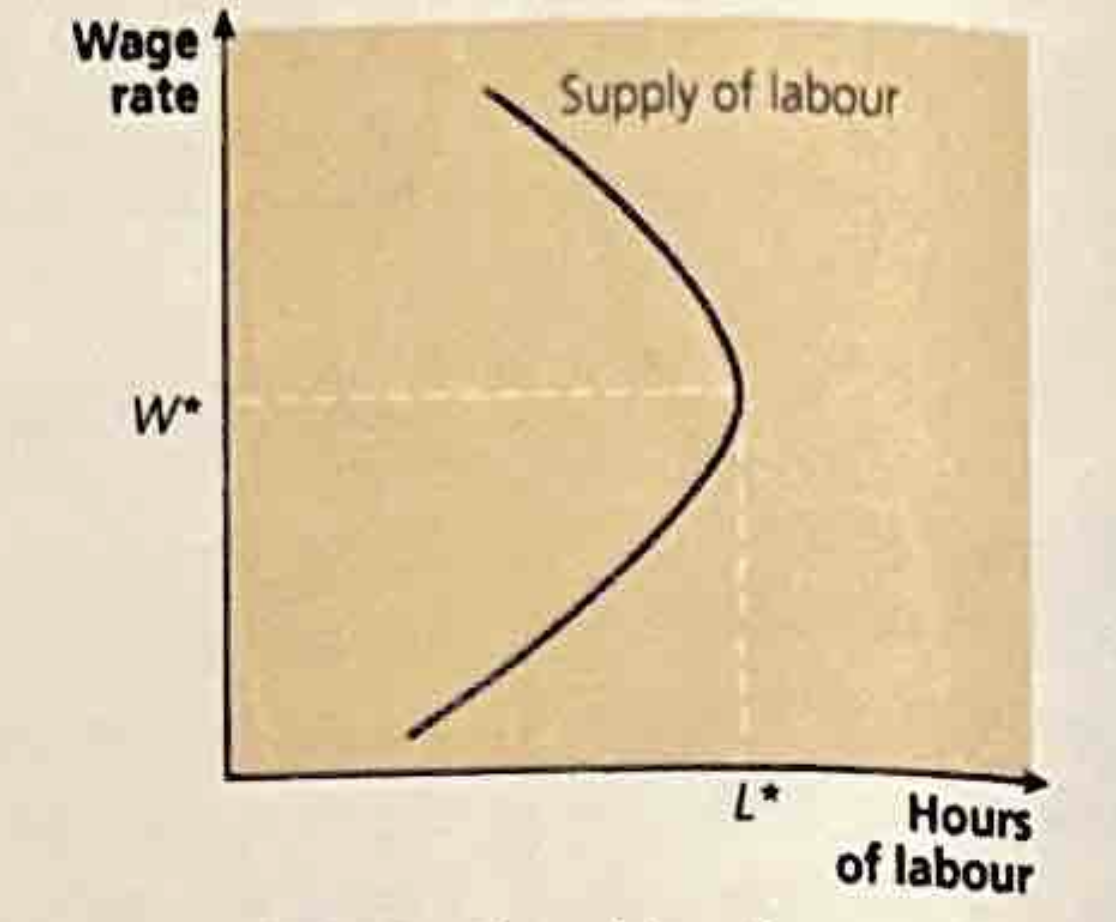
what factors influence the labour supply curves position
BASICALLY ANYTHING THAT INFLUNCES THE LIKELINESS OF SOMEONE APPLYING
wages in other industries (substituting for other employment), difficulty of acquiring skills and qualifications for job, number of appropriate candidates ie qualified, fringe benefits, demographic factors
what is the wage elasticity of supply defined as
the likeliness of the supply of labour changing when there is a change in the wage rate
what influences the labour supply curves shape
the elasticity of labour supply
what factors effect the elasticity of labour supply
the availability of workers (more= more elastic), skills (more = elastic), qualifications and commitment, labour immobility and geographical factors in the short run
when is labour supply most elastic
in the long run as there are more shifts in the workplace and more mobility ie more education action and ,more movement of people
transfer earnings
minimum payment required to keep a factor of production in its present use, regarding labour its the minimum wage the worker is willing to accept
how are transfer earnings represented on a labour demand and supply curve
the area below the equilibrium point on the curve (in red)
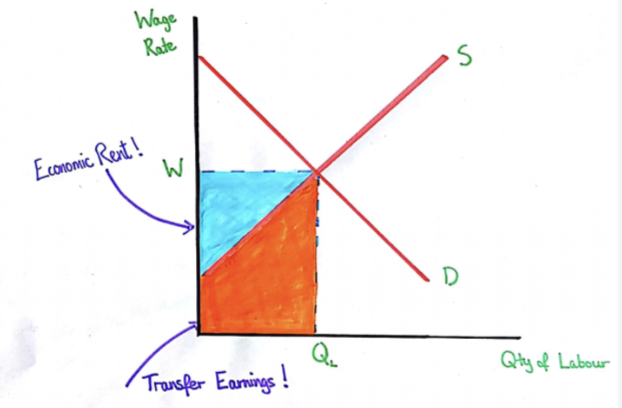
economic rent
the amount of money spent on a factor production above its transfer earnings ie anything above the minimum wage a worker is willing to accept
how is economic rent shown on a labour supply curve
area above the equilibrium point (blue)
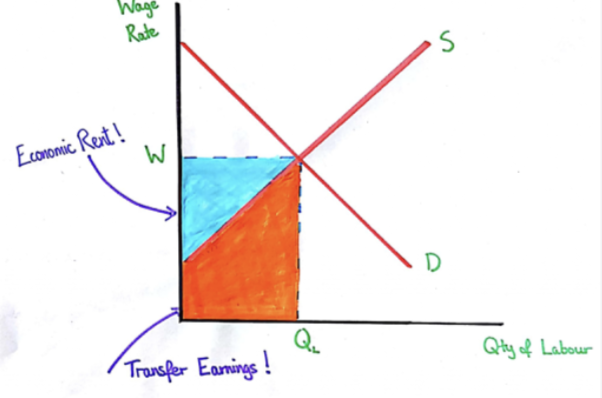
what influences the level of economic rent and transfer payments
the elasticity of the labour demand and supply curves
what does the choice of factors of production incur
an opportunity cost as people getting jobs means money cant be spent on capital etc
how can economic rent be very high
when a person is very marginally productive such as a footballer as they create more revenue for the firm
why may nurses and firefighters not have as high economic rent as celebrities and footballers
they are not as marginally productive as footballers and there is high demand for them
explain how wages can increase when product demand increases
product demand causes an outward shift in the demand of labour demand to meet needs, leads to a long run shift in wage differentials
what is the risk of firms not raising their wage when other industries do?
workers may switch to other industries and reduce the supply for the original firms labour
when looking at labour equilibriums, how should we assess the industry?
by looking at each industries supply and demand curves as they vary based on many factors ie technological developments will be more influential in the manufacturing labour market than the accounting labour market
what fundamental concept are wage differentials based on
the marginal productivity theory
what factors other than marginal productivity can influence wage differentials and why
qualifications as firms want workers that are educated, gender as there are gaps due to childcare responsibilities, geographical areas due to cost of living such as London
what is the gender pay gap and why does it occur
difference between the median salaries of men and women, 7% falling year on year, due to women being traditionally in the household and having more career breaks due to childcare
how can market failure occur in the labour market from a demand perspective
employers can discriminate when hiring through characteristics or wage differentials, employers that have market power can exploit people
how can market failure occur in the labour market from a supply perspective
trade unions can bid for wages above the market equilibrium level, some people that get employed may be under qualified or not work to their full potential
monopsony
market where there is a single buyer of a good, service or factor of production (labour in this case)
what does the monopsony labour supply curve look like and why
ability to pay lower wages (Wm) as they are the sole buyer and able to employ less workers (Qm) as diagram is read from MRpl=MCl
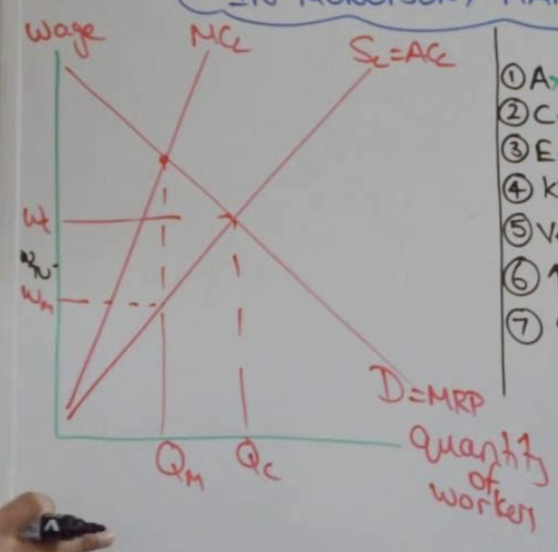
at what point do monopsonists perform at and why
where marginal revenue = marginal cost as they are in a position to maximise profit and are able to
evaluate the behaviour of a monopsonist
causes lower wages and fewer employed workers which impacts the economy through consumption, size of the impact of a monopsonist depends on the elasticity of the supply and demand of labour, limited employment means the monopsonist has greater control over labour
who can intervene with monopsonism
the CMA can intervene and deal fines for exploiting market power
trade union
organisation that represents workers to negotiate with employers on the behalf of its members
what three main goals do trade unions have
wage bargaining, improving workplace conditions, job security
what is closed shop and what is the situation with closed shop unions in the UK
where all members of an industries labour market are also members of a trade union so they can control the supply of labour to bargain with employers, now illegal in the UK
how can people be worse off when a trade union is in operation
those that are unemployed may not benefit as wage increases won’t affect them, those not a part of a trade union may not benefit
how can elasticity interfere with trade union behaviour
more inelastic labour demand sees a higher wage increase from trade unions as firms need the labour more than the employees
how can the PED of a product affect wage negotiations
if the product has a low PED ie will be consumed nonetheless then the additional costs of wages can be carried as a price increase to the consumer without loosing too much revenue
how can trade unions benefit a firm in the long run
is working conditions / wages/ job security is improved it is likely that the workers will perform better as they are happier in their position which can benefit the output of the firm as productivity is higher
bilateral monopoly
situation where a monopoly faces a monopsony (trade union/seller vs employer/buyer)
how does the case of a bilateral monopoly improve wage and employment conditions
the original monopsony wage of wm increases to w* as monopoly pushes it there, changes quantity to l* to regain equilibrium
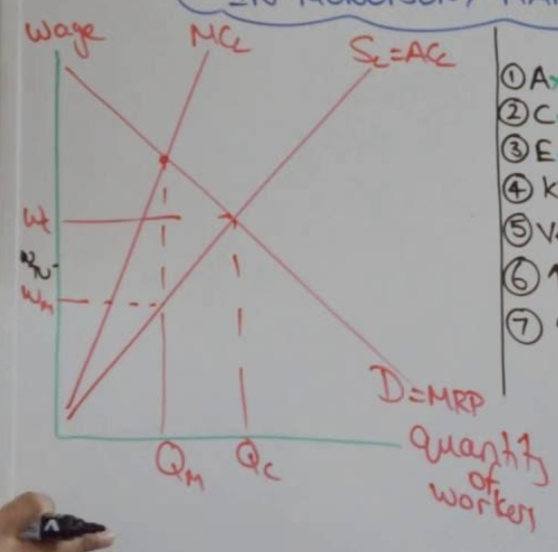
evaluate a bilateral monopoly
never really is a situation where they have equal power, firms will often have more bargaining power, trade unions more likely to improve working conditions than wages
what is labour market flexibility all about
how a market can efficiently allocate labour in order to achieve maximum efficiency, making sure no asymmetric information is present
what are six ways/ policies that improve the flexibility of a labour market
preventing information failure and improving occupational mobility, trade union reform, improving geographical mobility, regional policy, technology, contracts
how can focusing on occupational mobility and information provision improve labour market flexibility
incentivises employers to upskill people eg 2017 apprenticeship levy, take people from low skill to higher skilled jobs
how can focusing on trade union reform improve labour market flexibility
making it more difficult to call strike action to keep costs for firms lower, decline in trade union membership means less power
flip side-
existing employees have more information about job opportunities so it reduces flexibility, closed shop unions restrict labour supply
how can there be asymmetric information within hiring
employers can have workers and shirkers with the same qualifications and not realise ghat the shirkers do not have high marginal productivity until they are actually working for the employer, workers with high marginal productivity may go to a different firm that pays better therefore paying a higher wage to workers initially will reduce the labour turnover in the long run, called an efficiency wage
efficiency wage
the level above the equilibrium wage rate that employers may pay workers in order to incentivise them to stay and raise the opportunity cost of getting fired due to poor productivity
how can focusing on geographic mobility improve labour market flexibility
high social costs when considering moving to another town/city for work ie family, friends, schools, sports, council housing lists too, need to make sure people can relocate more easily
how can focusing on regional policy improve labour market flexibility
better outsourcing services and offices outside of areas such as London to give jobs to skilled people in other regions eg leeds, manchester
how can focusing on technology improve labour market flexibility
by outsourcing low skilled jobs abroad people can focus on ups killing the domestic labour force, technology replacing low skilled jobs can further improve quality of human capital, increases specialisation and decreases structural unemployment
how can focusing on contracts and employment legislation improve labour market flexibility
more zero hour contracts and part time contracts allows more labour participation and firms to have more flexible work forces
but
termination requirements ie notices means that the job market is less flexible, zero hour contracts are unpopular w workers
evaluate labour market flexibility
more flexible workforces maintain international competitiveness within the global economy as can specialise and up skill people, more worker based legislation leads to a decline in the flexibility of the labour market